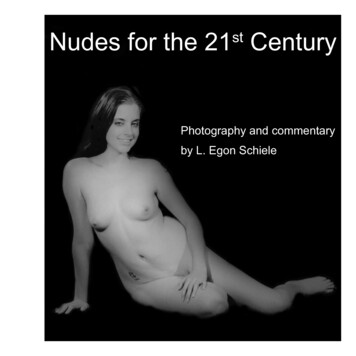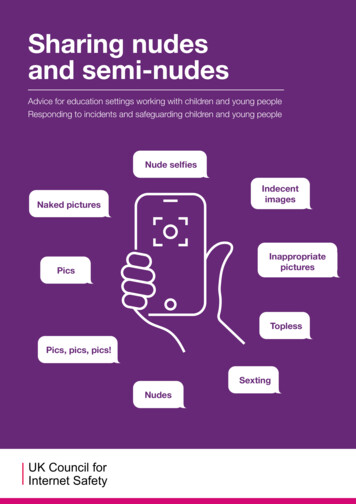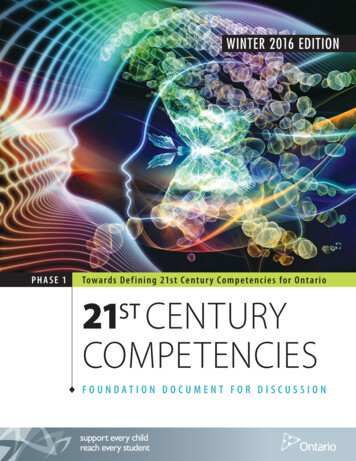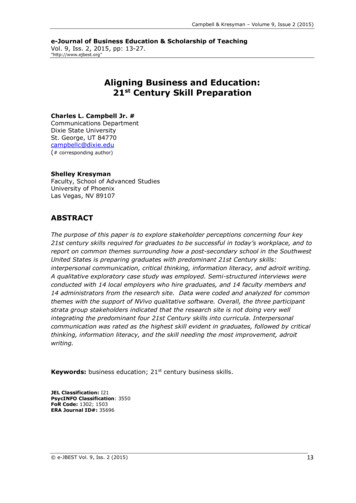
Transcription
Nudes for the 21 CenturyNudes for the 21st CenturystPhotography and commentaryby L. Egon Schiele
Nudes for the 21 CenturystPhotography and commentaryby L. Egon SchieleTable of contentsI. IntroductionA. What is new?B. What is old?C. What is myth and what is real?D. What is seen, scena, and obscene?E. What is the impact of photography?F. What is the 21st-Century nude?II. Portraits of the sitting nudeIII. Olympias, Odalisques, and other parodiesA. OlympiasB. OdalisquesC. Edward WestonD. Egon SchieleE. Wilhelm LehmbruckF. Ladder posesIV. PyramidsV. MadonnasVI. BodyscapesVII. Dance and sports
I. IntroductionA. What is new?To create the nude for the 21st Century, I haveexperimented with style to reflect the aestheticand societal evolution that accompanies thenew Millennium. I present the outcomes usingblack-and-white photography. This medium is inherently more abstract than, for example, colorphotography; and, as such, it provides a surrealmeans to represent the nude.Because the nude is the longest enduringtheme in the history of art, depicting the nudeto represent new aesthetic values requires innovation. Thus, the sine qua non of this workis that the 21st-Century nude differs in its visualimpact from the nudes of earlier epochs. Beforedescribing the features of the 21st-Century nudethat are evolutionary, I mention some aspects ofthe nude that reflect the tenor of earlier epochs.B. What is old?The Greeks of the 5th Century BCE were prolificsculptors of primarily male nudes. Their subjectswere anthropomorphic gods and goddessesand sports figures. Thus art glorified the beautyof the human body and was not associated withany religious proscriptions.In Biblical times, based on the content of theOld Testament, the Jews proscribed both publicand private nudity. Over more than two millennia, these proscriptions arising from the storyof Adam and Eve evolved into an intricate andconvoluted set of religious laws that is still operative in contemporary Orthodox Judaism.Because the Jewish dogma strictly forbade creating and worshiping idols, until modern times,Jews generally tended not to create visual art.Thus, these religious prohibitions of creatingrepresentations of nudity indirectly affected theevolution of Western art.Alana: Erlösung
As Christianity arose and developed, becoming a world religion, the taboos associated withviewing the human body evolved with it. Andthey remain operative today. Likewise, in Islam,related taboos evolved, which also have theirorigins in the Old and New Testaments and inthe Koran. These taboos strongly influencedthe evolution of Western art, both directly andindirectly.The direct influence meant that artists were notallowed to create paintings and sculptures ofactual, nude people. Until the mid 19th Century,both religious and secular authorities enforcedthis proscription strictly through the threat ofsevere sanctions. By the mid 19th Century, censorship and legal sanctions were still operative,but their effectiveness had diminished. Untilrecent times, the churches, the art academiesand the governments focused their authorityon attempting to enforce which elements of thenude should be more taboo than others. For example, many paintings of Victorian nudes showfemales having voluptuous breasts but havingno pubic hair or genitalia.The indirect influence was that artists created images of nude, ostensibly “non-human”figures that they depicted as humans. Theseanthropomorphic figures represented gods andgoddesses from Greek and Roman myths andcharacters from Biblical myths. Thus artists,such as Michelangelo, Titian, Rubens, Raphael,and many others, were able to create imagesof nudes that the observer could appreciate asrepresentations of humans without either theartist or the observer openly violating the taboo.Mikki: Contrapposto
C. What is myth and what is real?When artists depicted nudes as real people instead of as mythical characters, they could create new messages on various themes insteadof reiterating the theme of the ancient myth. Thedistinction was often subtle between the imageof a human and the image of a mythical figure.We consider several examples.Titian’s Venus of Urbino (ca. 1538) was and isa well known depiction of the Greek goddessVenus as a reclining nude. Whereas, in 1863,Édouard Manet painted Olympia, in which theprimary figure superficially resembles Titian’sVenus. However, Manet’s Olympia represents aprostitute who appears to look directly but indifferently at the viewer. Although the distinctionsbetween Venus and Olympia may have beensubtle, the exhibition in Paris of Manet’s Olympia created a taboo-breaking scandal, perhapsbecause some of the viewers may have knownthe model professionally. Moreover, Manet’spurpose was to create awareness of and condemnation of the Victorian double standard andhence to offer a new message to the viewer. Theensuing scandal represents his success.Alana: Flapper
In 1863, Manet painted Le déjeuner sur l’herbe,which he may have based on several Renaissance paintings that show nude female andclothed male figures from myths. In Le déjeunersur l’herbe, Manet painted a nude woman accompanied by two well dressed dandies whoare enjoying a picnic in a park while anotherwoman bathes in the background. Manet leavesthe subject of conversation between the threemain figures to the imagination of the viewer. Atraditional interpretation is that the park shownin the painting represents a Parisian park usedby prostitutes to meet clients and that the figuresare discussing an associated business arrangement. A contemporary interpretation is that Manet presents a patriarchal view of a woman, inwhich the clothed dandies represent controllersof the woman’s sexuality. Manet presents a limited view of the woman’s body, and that limitedview reflects the control of her sexuality.In 1899, Gustav Klimt, who was a leader of thecounter-academic-art movement, Wiener Secession, painted Nuda Veritas. This 2.6-meterhigh painting of a female nude, which has redhair, provoked and shocked Viennese society, inpart because Klimt included pubic hair in the depiction. With this taboo-breaking painting, Klimtassaulted the hypocrisy of Viennese society.Cassie: Orgasm
During this period, the University in Viennacommissioned Klimt to paint murals for thelarge lecture hall on the themes of philosophy,law, and medicine. Unlike the triumphant idealism of philosophy, law, and medicine that thoseacademecians who commissioned the workdesired to see expressed, Klimt used erotic depictions of nudes in these paintings to expressantithetical ideas, namely, the rise of existentialphilosophy, the dismal state of the system ofjustice, and the powerlessness of medicine.These works triggered a scandal in which Klimtwas labelled as a pervert and a pornographer.Gilles Néret, author of Gustav Klimt 1862 1918 (Taschen GmbH, Köln, 2003), describesthe painter’s viewpoint: “.Klimt is determinedto demolish the pillars of the temple and to offend the prudes by the representation of sexualarchetypes.” Klimt used the artistic representation of the nude to attack the hypocrisy of theera.As the Modern era waxed, the nude of yesteryear, which was an image of a god or goddess that reminded the viewer of antiquity, hadevolved into an image that carries a messageabout the present. For the artist, the nude hasevolved from a form with which to voice traditional themes from Classical and Biblical talesto a form with which to voice new and contemporary ideas and values.Cassie: Stretch
D. What is seen, scena, and obscene?Because of its history, depicting the nude often requires distinguishing between three categories of expression, art, pornography, andobscenity. In this context, I use the term “art”to refer to visual representations of the nude,namely drawings, paintings, photographs, andsculpture, in which the artist expresses an abstract idea through these media. The expressedidea may have an erotic element, but the eroticelement does not negate the aesthetic value ofthe work. Moreover, the erotic element violatesanother ancient taboo, namely, that viewing anude should not promote sexual arousal. In hisseminal work, The Nude: A study in ideal form,(Princeton, Princeton University Press, 1956)Kenneth Clark expresses the modern view: “nonude, however abstract, should fail to arouse inthe spectator some vestige of erotic feeling.”Likewise, in 1908, in his well known essay, Ornament und Verbrechen, the Viennese architect,Adolf Loos, states: Alle Kunst ist erotisch (all artis erotic).The distinction between art and pornography isthat pornography refers to a work that primarilyserves to arouse sexual desire; whereas, (nonpornographic) art must go beyond being onlyan instrument of sexual arousal. Obscenity isa type of pornography that is “non-art.” Mostlikely, the term “obscene” originates from theLatin term obscena; scena refers to the backdrop of a stage, and obscena refers to that toone side or off stage. In other words, the termobscene refers to that which shall not be shown.Pornography is not necessarily obscene, as thedistinction between pornography and obscenityremains controversial and unresolved in bothart and legal circles.Cassie: Seduction
Despite the ambiguity, I can offer an operationaldefinition. In contradistinction to art, the work inpornography shows people who are degradedinto sexual objects (or victims of violence).When the degradation becomes more extreme,the work becomes obscene. According to thisdefinition, photographs of nudes that includea view of the genital region are a priori neitherpornographic nor obscene. A non-inclusive butsimple rule is that, to be obscene, a work generally must show more than one figure, otherwiseshowing this “degradation” may not be possibleusing conventional methods.For adults, the First Amendment protects creating and viewing art and pornography, but it doesnot protect either obscenity or child pornography.Jodi: David
E. What is the impact of photography?So far, I have discussed the nude in the context of painting and sculpture, as these mediaspan the historical epochs. As a relatively newmedium, photography differs from these oldermedia in several salient ways. Although it wasinvented in the mid-19th Century, at least half ofa century needed to pass, before photography“came of age” as an art form in the early 20thCentury, photographers were creating imagesassociated with several genres, of which Pictorialism and Straight Photography are most worthyof note. Likewise, the technology needed toexecute photography required many decades todevelop. Specifically, starting during the latterpart of the 19th Century, the dry-plate process,roll film, highly corrected and sensitive lenses,and smaller formats provided the technicalmeans for the art of photography to advance.However, practical materials for recording highfidelity color photographs did not became readilyavailable until the late 1930s.In contradistinction to painting, photographycan be used to record images very rapidly andwith an extremely high degree of spatial resolution, and photographs can be reproduced inarbitrarily large numbers with no loss of quality.Likewise, using digital representations of photographs and the Internet, photographers candisplay images worldwide. This technology hasgiven rise to a rapidly increasing inventory ofphotographs of human figures, which are available in a variety of formats and are accessibleby many audiences. In the context of the nude,the potentially high spatial resolution of photography means that the model may be readilyidentified in a photograph and that, for practicalpurposes, the level of detail presented in a photograph is limited by the photographer’s artisticjudgment and taste.Diane: Stretching
F. What is the 21st-Century nude?To characterize the 21st-Century nude, I describe a non-exclusive group of features, whichmay differentiate this nude from nudes of earliereras. In the chapters that follow, I present manyexamples.Until recently, artists have presented a patriarchal view of the female nude. Because mostartists have been men and because Westernsocieties have been dominated by men, artistshave rendered the female nude devoid of eitherpubic hair or genitalia. This restriction symbolizes control by men of the sexuality of women.The nude of the 21st Century represents a rejection of this control and consequently an expression of female sexuality.A related patriarchal force is creating an arbitrarystandard of beauty, which has changed over thecenturies in Western cultures. During the latter part of the 20th Century, in US print media,film, and especially advertising, the commercialartists have created the image of a beautifulwoman as Caucasian, blond, and very thin,perhaps emaciated. In the 1960s, the “BarbieDoll” emerged as a commercial icon of this image. Likewise, many talented women who wantto model but whose body morphology deviatesfrom this image have not been able to expresstheir talents commercially as models. This nearly anorexic image represents an ideal that mostwomen cannot and should not achieve; and, assuch, it also serves as a male means of control.Thus, the models who become the nudes of the21st Century represent a broad variety of bodymorphologies.Diane: David
The photographic representation of the 20thCentury nude often exhibits the recrudescenceof the ancient taboos, namely, covering or obscuring the genitalia, which the photographercan execute using a variety of modern techniques, e. g., air brushes. Another manifestation of this taboo arises when the photographereither poses the model or edits the photographso that the face is not visible but the genitals arevisible. A variation of this approach is to removethe head in the image, either while composingthe photograph or while editing the image. Andmany photographers do record photographsof torsos and other body parts, and they callthem compositions in light and shadow. However, depicting the human figure as an isolated,separated, and abstract part of the human body,e. g., as a headless torso, reduces the modelfrom a person to an object or thing. To representthe 21st-Century nude, the photographer doesnot record images of only body parts, whichdegrades a person into a thing or object. The21st-Century nude is a complete person whoseidentity is neither truncated nor otherwise obliterated.Kristy: Contemplating
II. Portraits of the sitting nudeTo the viewer, the portrait presentstwo types of information, which arenot always mutually exclusive.Firstly, the artist can providean objective expression of theappearance of the subject. Examples of this type of portrait arepaintings created using the styleof Realism and most commercialphotographic portraits.Secondly, the artist can providea subjective expression aboutthe nature of the person who isthe subject. This expression mayarise from the representation ofphysical features, of which thecaricature is an extreme example.Alternatively, the artist may createthis expression either by deviatingfrom reality or by strongly emphasizing reality. For example, insome of the portraits painted bythe German Expressionists, theartists used colors, shapes, facialexpressions, and poses that cannot correspond to reality. Instead,to the viewer, these features express some abstract idea aboutthe subject.Mikki: Depicted in Chiaroscuro
The photographer does not haveas many means as the painter,with which to express a subjectiveidea. For this purpose, the photographer can use posing (includingprops), lighting, and the technicaloptions associated with creatingthe photograph, e. g., focal lengthof the lens, depth of field, typeof film, and so forth. The viewersees the results of posing andlighting directly, but the effects ofthe myriad of technical considerations remain obscure.In contradistinction to the painterwho may use technique to deviatefrom reality, the photographer mayuse posing, lighting, and technicaladjustments to emphasize reality.For example, Edward Steichencreated portraits of many famouspeople. He emphasized certainfeatures that suggest the origin ofthe person’s fame. In Steichen’sportrait of the great dancer, FredAstaire, a larger-than-life shadowof Astaire holding his hat andcane is cast onto the backdrop.The hat and cane, i. e., “tools” ofthe dancer, emphasize Astaire’sproficiency as a dancer.Mikki: Relaxed
As a pose, the sitting nude offers avariety of opportunities to expressideas. Using relatively uniformlighting, the photographer maymake the physical features visible, which can create a mood ofopenness and which can providea means to emphasize the beautyof the model. Alternatively, usinghigh-contrast lighting, the photographer can create other moodssuch as uncertainty by leavingpart of the image in shadow. Likewise, the shadows obscure detailsthat leave part of the image to theviewer’s imagination.The photographer can use posingobjectively. For example, a pose inwhich the model arches her backallows the photographer to emphasize objectively the beauty ofher breasts. Likewise, for a modelwhose breasts are sagging, thispose allows the photographer tooffset the sagging to enhance theaesthetic appeal of the model.Mikki: Contemplating
Alternatively, the photographercan use posing subjectively.When the model’s hands are holding her legs, while she is sitting onthe floor, she may appear relaxed.Thus, the model may create correspondingly a relaxed mood,which she can enhance by smilingand looking toward the camera.Alternatively, the model may appear tense, when, for example,she is balancing herself, whileshe is sitting on a stool with herleg extended. The photographermay want to create a tense mood,for example, because, the posecould be either a parody or animprovisation based on anotherwork. In addition to the articulation of her body, the model’s facialexpressions may suggest actionssuch as thinking or flirting. In thecontext of lighting and posing,I have mentioned a few examples.They serve as a guide for viewingthe 21st -Century, sitting nude.Jodi: Relaxed
Sara: Rotating
Trish: Smiling and thinking
Trish: Relaxing and contemplating
Jodi: Relaxing and contemplating
Jodi: Reclining and contemplating
Melissa: Contemplating
Leslie: Stretching
Leslie: Relaxing
Trish: Remembering Marlene
Cassie: Remembering Marlene
Jodi: Remembering Marlene
Mikki: Remembering Marlene
Mikki: Remembering Marlene
Mikki: Remembering Marlene
Jodi: Fantasizing
Jodi: Secretly contemplating
Trish: Contemplating play time
Jodi: Contemplating play time
Sara: Reclining and contemplating
Jess: Contemplating the next move
Katie: Relaxing, contemplating, and reclining
Diane: Straight ahead
Diane: Looking upward
Alana: Chairman of the board
Alana: Bored of the chairman
Kristy: Sitting on the ball
Kristy: Stretching on the ball
Alana: Crossing X
Alana: Triangles
Alana: Right triangle
Alana: Right triangle
Alana:Crossed
Alana: Contemplating the upstairs
Alana: Machine without the machine
III. Olympias, Odalisques, and other parodiesA. OlympiasTitian’s Venus of Urbino (ca. 1538) and Monet’s Olympia (1863)appear superficially to be similar images, as Manet based thelatter on the former. Titian’s Venus is a Classical depictionthat had not confronted the viewer as an expression of power.Moreover, in 1863, Alexandre Cabanel painted The Birth ofVenus, in which he rendered Venus in the Classical style, asa goddess. Although Cabanel painted this Venus anatomicallyaccurately and very erotic in appearance, the image wasexhibited in the Salon in Paris, where it represented a masteryof academic art of the era. The viewer may have appreciatedthe eroticism of this Venus, but was not confronted by thesexuality of the image. And Napoleon III bought the paintingfor his private collection.Alana: OlympiaIn contradistinction to the Classical Venus, Manet’s Venus provokedits viewers of the mid 19th Century, because the image confrontedthem with their own hypocrisy.Several models improvised on Manet’s Olympia. The resultingparodies provide impressions of the Olympia of the 21st Century,which differ fundamentally from the Olympia of Manet’s era.
Alana: Olympia
Melissa: Olympia
Lynn: Olympia
Lynn: Olympia
B. OdalisquesIn 1814, Jean-Auguste-Dominique Ingres painted the GrandeOdalisque. The term “odalisque” refers to a female slave in asultan’s harem. Because Napoleon waged a military campaignagainst the British in North Africa, The French became awareof the harem as an institution. During and after the FrenchRevolution, some French women united to demand equallegal rights, which did not happen until 1944. Some uppermiddle-class European men may have viewed the haremas representing a movement counter to the recently formedwomen’s movement for suffrage and equal legal rights.Leslie: Grande OdalisqueThis background suggests why the odalisque became a subjectof French painting. Moreover, the connection of the odalisque tothe movement for women’s rights suggests why Ingres’ GrandeOdalisque should be the basis for improvisation. However, someof the physical features of Ingres’ Grande Odalisque, such as thewoman’s curving back, depart from anatomical reality. As such,pose is difficult to execute. Nonetheless, several models improvisedon the Grande Odalisque to provide parodies that give impressionsof the 21st-Century “odalisque.” These images represent in no wayan odalisque, but they represent images of politically and sexuallyliberated women.
Melissa: Grande Odalisque
Cassie: Grande Odalisque
C. Edward WestonDuring his long career (ca. 1903 - 1948),Edward Weston photographed a large variety ofnude models. Especially in many of his earlierphotographs, Weston shows parts of bodies,although in some photographs he does showrecognizable faces of models who are posingnude. The tenor of the times probably influencedWeston’s style. Works that were exhibited,published, sold, or mailed were subject to theComstock Act of 1873 (Federal Anti-ObscenityAct), which was enforced in an arbitrary andcapricious manner, as no satisfactory definitionof “obscenity” was operative. As a result,mailing a picture that showed, for example,pubic hair, could lead to Federal prosecution.Thus, we must consider the aesthetic elementsof Weston’s compositions in the context of hisperception, namely, that legal sanctions couldbe imposed arbitrarily.In Edward Weston’s photograph, Nude, (1927),he shows a profile view of the lower part of anude woman who is squatting. The part of theimage the would show the woman upwardfrom the mid torso is missing. Several modelsimprovised to create their impressions of themissing part of Weston’s model.Cassie: Improvising on a theme by Edward Weston
Kristy: Improvising on a theme by Edward Weston
Nicole: Improvising on a theme by Edward Weston
Nicole: Improvising on a theme by Edward Weston
D. Egon SchieleEgon Schiele was a member of WienerSecession, and he was, like GustavKlimt, an opponent of academic art andits stylistic dogmatism. Schiele developedhis style of drawing and painting usingKlimt’s work as a model. His portraitsof nudes are generally strongly erotic;and, as such, his depictions of nudes,including self portraits, were verymuch ahead of their time. Moreover, tomainstream Viennese art viewers duringthe first two decades of the 20th Century,Schiele’s nudes appeared provocativeand pornographic. Today these drawingsand paintings are widely exhibited, andthey serve as models for contemporaryartists.In 1914, Schiele created a gouacheand-pencil drawing, entitled SitzenderMädchenakt (girl posed sitting). We usedthis drawing as the basis for improvisationto create impressions of the 21st-Centurynude posing for a contemporary Schiele.Cassie: Sitzender Mädchenakt (girl posed sitting)
Cassie: Sitzender Mädchenakt (girl posed sitting)
Alana: Sitzender Mädchenakt (girl posed sitting)
Diane: Sitzender Mädchenakt (girl posed sitting)
Diane: Sitzender Mädchenakt (girl posed sitting)
Jessica: Sitzender Mädchenakt (girl posed sitting)
Leigh Anne: Sitzender Mädchenakt (girl posed sitting)
Trish: Sitzender Mädchenakt (girl posed sitting)
E. Wilhelm LehmbruckIn 1911, Wilhelm Lehmbruck, a GermanExpressionist, created the sculpture, DieKniende (The kneeling woman). The workof the French sculpture, Auguste Rodin,influenced Lehmbruck’s earlier sculptures. InDie Kniende, which represents a departurefrom his earlier style, Lehmbruck elongated theproportions especially the neck. The elongationand the small, widely separated breasts alludeto the Gothic style of depicting the nude. Weused this sculpture to create an impressionof how the 21st-Century nude would executeLehmbruck’s pose.Alana: Die Kniende (The kneeling woman)
Alana: Die Kniende (The kneeling woman)
F. Ladder posesJodi: Ladder-day saint
Jess: Ladder-day saint
Kristy: Ladder-day saint
Melissa:: Ladder-day saint
IV. PyramidsThe pyramid symbolizes strength and stability. For the nudeof the 21st Century to evoke a feeling of strength and stability,I sought a pose that has the geometric characteristics of apyramid. Thus, we developed the pyramid pose, in which thelegs of the model form the base of a trigonal pyramid. Thetorso with the head at the apex corresponds to the edgeformed by two of the three sides. The model can place thearms and hands to suggest where the three sides are locatedin space. Alternatively, the model can use the arms and handseither to gesture or to extend the height of the apex. I show avariety of examples that illustrate these ideas.Leigh Anne: Slanted pyramid
Leigh Anne: Truncated pyramid
Leigh Anne: Straight pyramid
Leigh Anne: Inverted pyramid
Diane: Extended pyramid
Diane: Stretched pyramid
Alana: Sensual pyramid
Jess: Contemplating pyramid
Jessica: Stretched pyramid
Kristy: Relaxed pyramid
Kristy: Twisting pyramid
Kristy: Extended pyramid
Katie: Relaxed pyramid
Leslie: Relaxed pyramid
Leslie: Stressed pyramid
Mikki: Oblique pyramid
Mikki: Extended pyramid
Mikki: Stretched pyramid
Nicole: Relaxed pyramid
Nicole: Sensual pyramid
Sara: Contemplating pyramid
Trish: Oblique pyramid
Trish: Extended pyramid
Cassie: Seductive pyramid
Cassie: Rotating pyramid
Cassie: Inverted pyramid
V. MadonnasGenerally, the term Madonnarefers to Mary, the mother ofJesus; and, since the era of theEarly Christian Church (ca. 30 325 AD) through to the present,many artists have depicted theMadonna. They include Leonardoda Vinci and Michelangelo duringthe Renaissance, Caravaggio andRubens during the Baroque, andSalvador Dali and Henry Mooreduring the Modern. Literally, theterm Madonna originates frommedieval Italian, and it meansa noble or otherwise importantwoman. In the historical contextof these artists, the Madonna isa fundamental icon of Christianity,and it represents a chaste andmature woman who miraculouslygives birth to Jesus.In 1894-95, the Norwegianartist, Edvard Munch, paintedseveral versions of an imageof a sensuous, nude womancalled Madonna. A well knownAlana: Madonnainterpretation of this Madonnais that the image represents awoman engaged in producing lifeduring sexual intercourse. TheMadonna of Munch representsa modern and sexually liberatedview of a woman. For this reason,the Madonna of Munch becamethe basis for improvisations, inwhich the nude of the 21st Centuryexpresses her sexuality.
Alana: Madonna twisting
Diane: Madonna contemplating
Diane: Madonna smiling
Diane: Satisfied Madonna
Trish: Etherial Madonna
Jodi: Madonna in thought
Jess: Madonna watching
Jess: Madonna watching and turning
Jess: Madonna thinking
VI. BodyscapesIn the bodyscape, the photographer uses light and shadow toaccentuate the curves and contours of the body. The modellies on the floor of the studio and relaxes. The poses aregenerally sensuous and erotic. Often artists have depictedlandscapes to emphasize the natural beauty of the featuresof the landscape such as vegetation, mountains, valleys,and rivers. Moreover, the tacit message of the landscape isthat the landscape is not simply a collection of independentcomponents such as vegetation, mountains, and rivers.Instead, the beauty consists of the integrated, whole segmentof the earth’s surface pictured in the landscape. Likewise,the bodyscape presents the beauty of the model’s body as aperson and not as a collection of body parts.Jodi: FantasizingIn this context, I mention the 1866 painting of Gustave Courbet,L’Origine du monde, in which he depicts the genital region of anude woman. In Courbet’s time, many viewers considered thepainting to be scandalous. Today, as a very important contributionto the evolution of art, this painting belongs to the collection of themuseum, Musée d’Orsay, in Paris. With this painting, Courbet brokea long standing taboo that proscribed creating images of femalegenitals and that still is operative among many groups of artists.Moreover, this painting and the works of Manet have contributedstrongly to changing the way in which the nude is portrayed in art.Because of its importance, we used it as the subject of parodies.Unlike Courbet’s image from which he truncated the face andconsequently obliterated the identity of the model, in these parodies,I show a complete image.
Leslie: Parody on Gustave Courbet’s L’Origine du monde
Leslie: Relaxing
Jess: Parody on Gustave Courbet’s L’Origine du monde
Alana: Contemplating
Mikki: Contemplating
Mikki: Shown in Chiaroscuro
Mikki: Smiling
Mikki: Imagining
Trish: Parody on Gustave Courbet’s L’Origine du monde
T
theme in the history of art, depicting the nude to represent new aesthetic values requires in-novation. Thus, the sine qua non of this work is that the 21st-Century nude differs in its visual impact from the nudes of earlier epochs. Before describing the features of the 21st-Century nude that are evolutionary, I mention some aspects of










